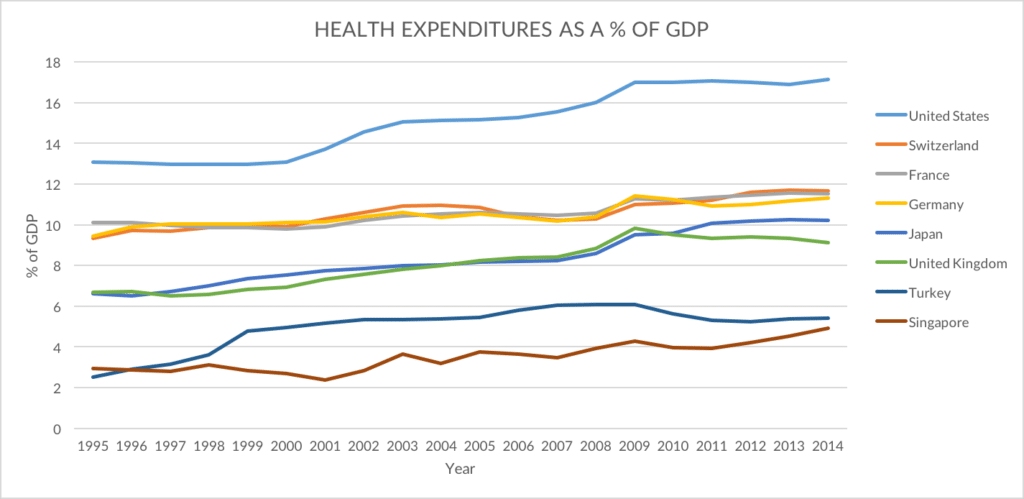The current state of healthcare in the United States leaves much to be desired. In spite of spending considerably more than other wealthy countries as a percentage of GDP, our health system has failed to improve the overall health of most Americans. Since 1960, the proportion of adults suffering from at least one chronic condition has increased dramatically. Obesity among adults has risen from 13% to a staggering 36%; the percentage of Americans with diabetes has climbed from under 1% to 7%; and hypertension now affects 29% of adults, compared to only 15% two decades ago.
In 2014, the U.S. spent 17% of its GDP on healthcare. Comparatively, France spent 12%, Japan spent 10%, and the U.K. spent 9%. | Source: The World Bank
A major contributor to the problem is the fact that government efforts are focused on helping Americans afford healthcare, rather than making healthcare affordable. If we truly want to reduce healthcare costs and improve the health of all Americans, a paradigm shift is needed that refocuses our efforts on making healthcare affordable from the start. Disruptive Innovation is the mechanism that can help us accomplish this, and nutrition shows great disruptive potential.
The Theory of Disruptive Innovation describes the process by which simple, affordable innovations replace expensive, complex systems and products, thereby increasing accessibility and affordability for all. It’s what Wikipedia did to encyclopedias, and email did to the U.S. Postal Service.
Healthcare is beset with complex problems, turning many well-intentioned people into crusaders for complex, oftentimes expensive solutions. This notion, however, is misguided. Disruptive Innovations start by solving simple problems first, but over time, they build momentum and improve until they are able to displace traditional, more costly approaches. Following that same pattern, nutrition has the potential to fundamentally disrupt the way in which healthcare is practiced.
“Let food be thy medicine and medicine be thy food.”- Hippocrates
Today, roughly 75% of healthcare spending in the United States is for preventable, chronic illnesses, covering costly procedures and treatments after we get sick. What if that number were closer to zero? While not all preventative measures are created equal—certain cancer screenings, for instance, are very expensive and produce few health benefits for the population at large—research suggests that adhering to a whole foods, plant based (WHPB) diet could make a world of difference.
In what was called “the Grand Prix of epidemiology” by The New York Times, the China Study, directed by Dr. Colin Campbell, analyzed the health of 6,500 Chinese adults across 65 counties to better understand the connection between diet, lifestyle, and disease. The study spanned 20 years and provided powerful evidence that identified a major culprit of many problems currently ailing society—that consumption of animal products is significantly correlated with chronic disease. Findings among the affluent disease group, for instance, showed that mortality rates were most often caused by high rates of plasma cholesterol, which was significantly and positively correlated with animal protein consumption. *
The good news: a whole foods, plant-based diet appears to be the antidote. Among the China Study’s affluent disease group, plasma cholesterol was inversely correlated with plant protein. Better yet, additional studies have shown that even in cases where individuals were genetically predisposed to disease, making this lifestyle change can prevent and manage diseases such as cancer, heart diseases, and diabetes. Pretty astonishing, especially when you consider that the U.S. spent $125 billion on cancer care in 2010, $215.6 billion on heart diseases in 2011, and $101.4 billion on diabetes in 2013.
Armed with this powerful information, innovators, healthcare professionals, and policymakers may have the secret weapon to disrupt the way we currently provide and receive healthcare. Rather than turning to specialists, prescription drugs, and costly procedures to cure our ailments after they present themselves, adhering to a WFPB diet would result in cost savings that Americans so desperately need.
Of course, as a country we will have to effectively reframe the way in which we think of healthcare, and be prepared to make significant behavioral changes. With nutrition as the catalyst behind innovative delivery models that educate, support, and connect individuals looking to improve their health, our healthcare system will finally live up to its potential to provide quality, affordable healthcare.
*The r-coefficient between plasma cholesterol and animal protein consumption was found to be 0.43 with a p-value < 0.001.
For more, see:
Seize the ACA: The innovator’s guide to the Affordable Care Act




